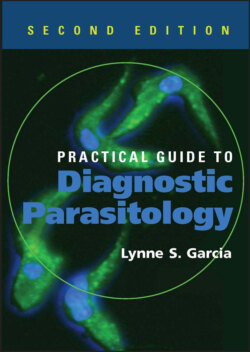Читать книгу Practical Guide to Diagnostic Parasitology - Lynne Shore Garcia - Страница 59
На сайте Литреса книга снята с продажи.
Trypanosomes
ОглавлениеThe trypanosomes are normally identified to the species level based on geographic exposure history and clinical symptoms. These protozoa are characterized by having, at some time in the life cycle, the trypomastigote form with the typical undulating membrane and free flagellum at the anterior end. Unfortunately, the longer the duration of the infection, the more difficult it may be to confirm the diagnosis. The organisms that cause African sleeping sickness (T. b. gambiense and T. b. rhodesiense) generally cause different disease entities; one tends to be chronic and more typically the patient appears to have sleeping sickness (T. b. gambiense), and the other causes a more fulminant disease often leading to death before typical sleeping sickness symptoms can develop (T. b. rhodesiense).
The etiologic agent of American trypanosomiasis (formerly South American trypanosomiasis) is T. cruzi, which contains amastigote and trypomastigote stages (in the mammalian host) and the epimastigote form (in the arthropod host). Human American trypanosomiasis, or Chagas’ disease, is a potentially fatal disease of humans. It has two forms, a trypomastigote found in human blood and an amastigote found in tissues. The acute form usually goes unnoticed and may present as a localized swelling at the site of entry of the parasites in the skin. The chronic form may develop 10 to 20 years after infection. This form affects internal organs (e.g., the heart, esophagus, colon, and peripheral nervous system), and patients may die from heart failure. In 2007, the Red Cross began screening donor blood units for antibody to this parasite. Also, the geographic range of T. cruzi within the United States continues to expand and now includes all of Texas. Infected triatomid bug vectors are also present in other states such as California.
